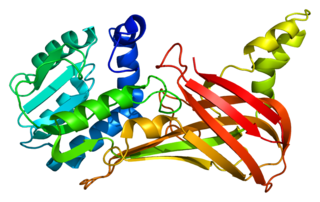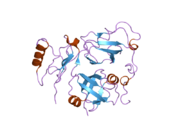
Trpc4-associated protein is a protein that in humans is encoded by the TRPC4AP gene.

Ubiquitin-associated protein 1 is a protein that in humans is encoded by the UBAP1 gene.

Kaptin is a protein that in humans is encoded by the KPTN gene.

Sister chromatid cohesion protein PDS5 homolog B(PDS5B) is a protein that in humans is encoded by the PDS5B gene. It is a regulatory subunit of the Cohesin complex which mediates sister chromatid cohesion, homologous recombination and DNA looping. The core cohesin complex is formed of SMC3, SMC1, RAD21 and either SA1 or SA2. PDS5 associates with WAPL to stimulate the release of cohesin from DNA but during DNA replication PDS5 promotes acetylation of SMC3 by ESCO1 and ESCO2.

Putative Polycomb group protein ASXL1 is a protein that in humans is encoded by the ASXL1 gene.

STAGA complex 65 subunit gamma is a protein that in humans is encoded by the SUPT7L gene.

DCC-interacting protein 13-beta is a protein that in humans is encoded by the APPL2 gene.

Protein arginine N-methyltransferase 3 is an enzyme that in humans is encoded by the PRMT3 gene.

Phosphoribosyl pyrophosphate synthetase-associated protein 2 is a protein that in humans is encoded by the PRPSAP2 gene.

HMG box transcription factor BBX also known as bobby sox homolog or HMG box-containing protein 2 is a protein that in humans is encoded by the BBX gene.

Integrator complex subunit 12 (Int12) also known as PHD finger protein 22 (PHF22) is a protein that in humans is encoded by the INTS12 gene.

Dynactin 5 (p25) is a protein that in humans is encoded by the DCTN5 gene.

CSRP2 binding protein is a protein that in humans is encoded by the CSRP2BP gene.

MDN1, midasin homolog (yeast) is a protein that in humans is encoded by the MDN1 gene. Midasin is a member AAA ATPase family.

Mitochondrial translational release factor 1-like is a protein that in humans is encoded by the MTRF1L gene.

Mitochondrial methionyl-tRNA formyltransferase is a protein that in humans is encoded by the MTFMT gene.

Coiled-coil domain containing 137 is a protein that in humans is encoded by the CCDC137 gene.

Solute carrier family 41, member 3 is a protein that in humans is encoded by the SLC41A3 gene.

Spinster homolog 2 (Drosophila) is a protein that in humans is encoded by the SPNS2 gene.

DIP2 disco-interacting protein 2 homolog B (Drosophila) is a protein that in humans is encoded by the DIP2B gene. A member of the disco-interacting protein homolog 2 protein family, it contains a binding site for the transcriptional regulator DNA methyltransferase 1 associated protein 1, as well as AMP-binding sites. The presence of these sites suggests that DIP2B may participate in DNA methylation. This gene is located near a folate-sensitive fragile site.





















